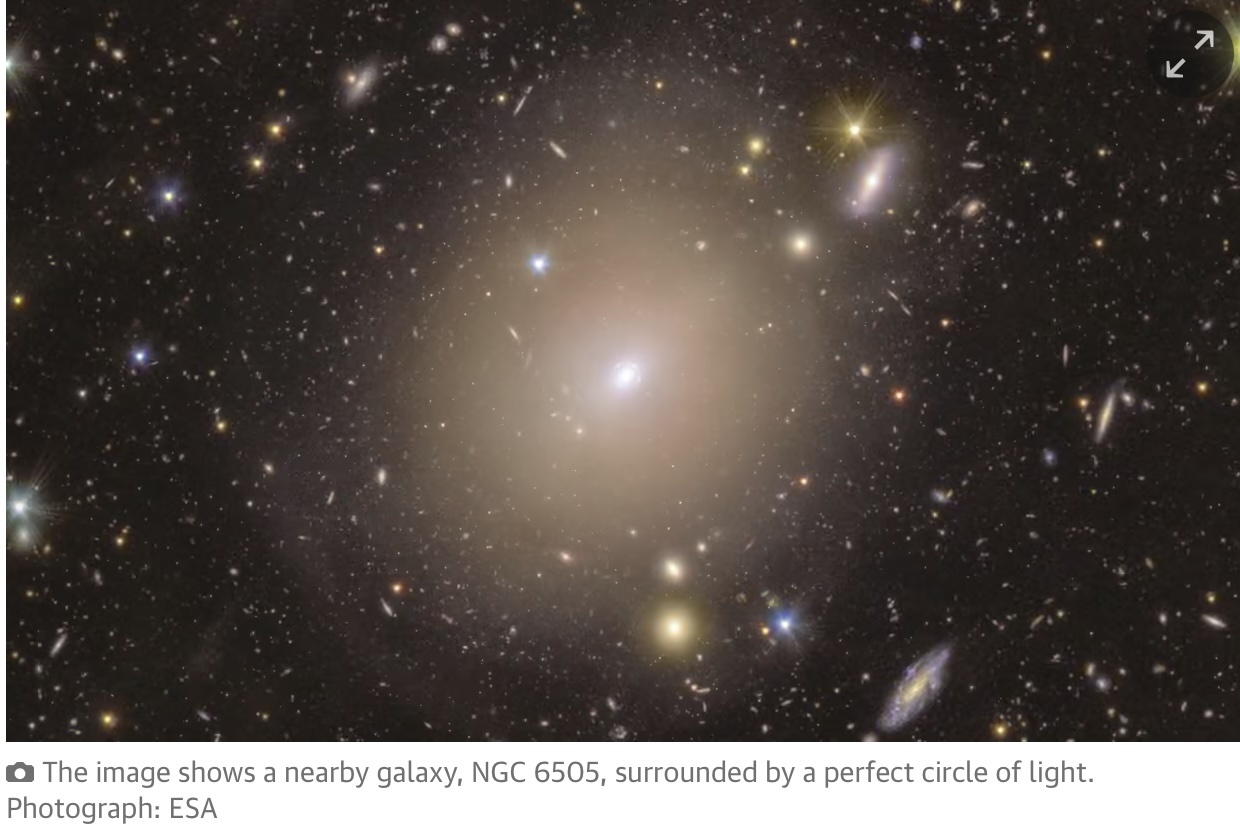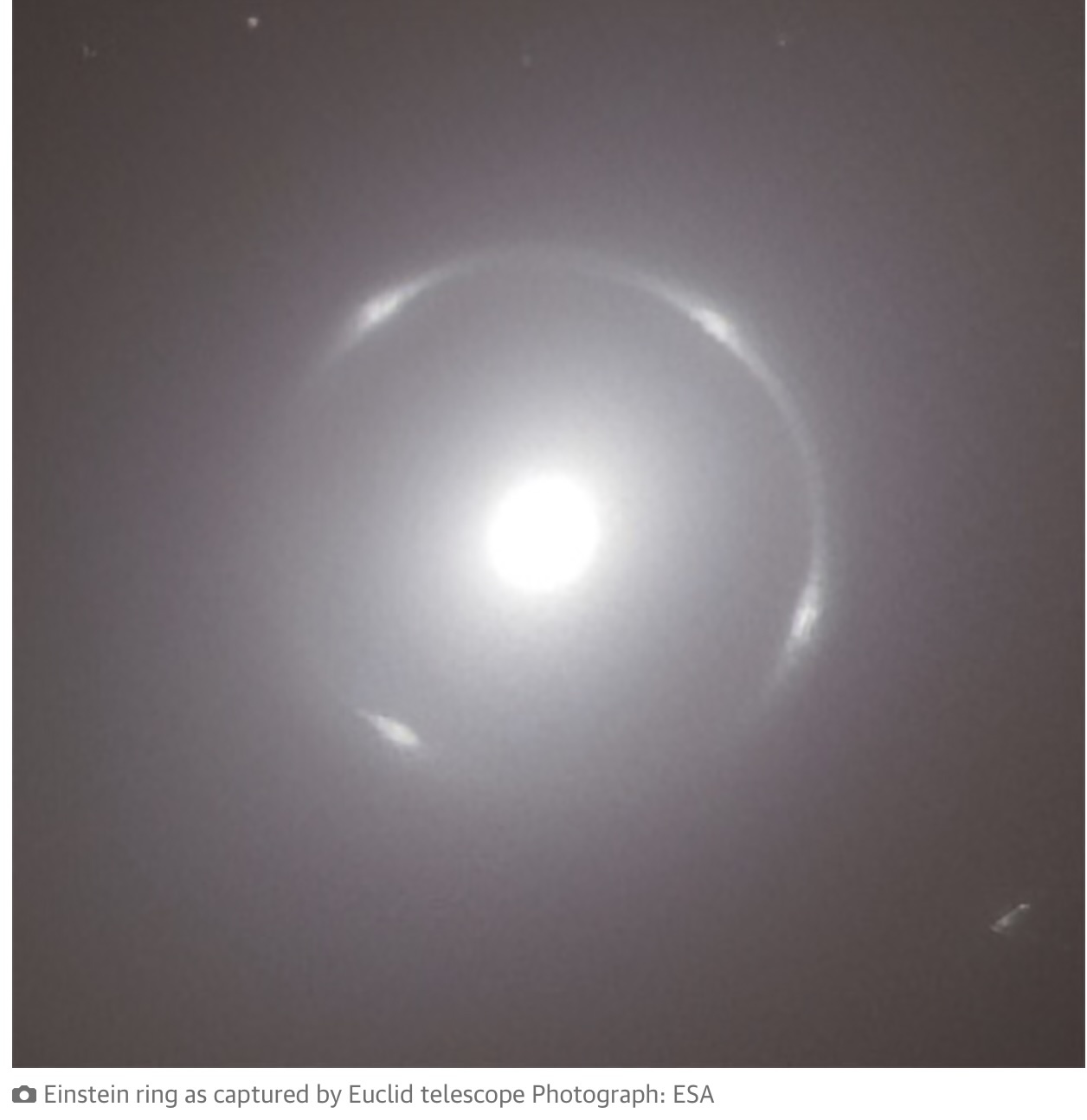10.02.2025
Dazzling image shows galaxy more than 4bn light years away, whose starlight has been bent due to gravity

The Euclid space telescope has captured a rare phenomenon called an Einstein ring that reveals the extreme warping of space by a galaxy’s gravity.
The dazzling image shows a nearby galaxy, NGC 6505, surrounded by a perfect circle of light. The ring gives a glimpse of a more distant galaxy, sitting directly behind NGC 6505, whose starlight has been bent around the foreground galaxy.
“This is a beautiful, extraordinary, thrilling and lucky find in our first data,” said Prof Stephen Serjeant, an astronomer at the Open University. “An Einstein ring as perfect as this is extremely rare. We get to see a background galaxy through the warped space and time of a very nearby foreground galaxy.”
Albert Einstein’s general theory of relativity predicts that light will bend around massive objects in space, meaning that galaxies can act as vast lenses. Einstein rings are a powerful tool for astronomers because they reveal objects that would otherwise be obscured from view and indicate the mass of the intermediate galaxy – including any hidden mass in the form of dark matter.
In this case, astronomers estimate that the foreground galaxy comprises roughly 11% dark matter. This is a relatively small fraction given that dark matter is believed to dominate the overall mass content of the universe.

Uncovering the secrets of dark matter and dark energy, which together make up 95% of the universe, is the central aim of the European Space Agency’s €1bn (£850m) mission. Ultimately the telescope, which can detect galaxies out to 10bn light years, is aiming to create the largest cosmic 3D map ever made. This will allow astronomers to infer the large-scale distribution of dark matter and reveal the influence of dark energy, a mysterious force that is accelerating the expansion of the universe.
The telescope will capture images of objects up to 10bn light years away, but the latest image shows its unmatched ability for razor-sharp observations is revealing new structures in the nearby universe, too. The NGC 6505 galaxy is about 590m light-years from Earth – a stone’s throw away in cosmic terms – and the unnamed background galaxy is 4.42bn light years away.
“I find it very intriguing that this ring was observed within a well-known galaxy, which was first discovered in 1884,” said Dr Valeria Pettorino, ESA Euclid project scientist. “The galaxy has been known to astronomers for a very long time. And yet this ring was never observed before. This demonstrates how powerful Euclid is, finding new things even in places we thought we knew well.”
Quelle: The Guardian
+++
Euclid discovers a stunning Einstein ring
Euclid blasted off on its six-year mission to explore the dark Universe on 1 July 2023. Before the spacecraft could begin its survey, the team of scientists and engineers on Earth had to make sure everything was working properly. During this early testing phase, in September 2023, Euclid sent some images back to Earth. They were deliberately out of focus, but in one fuzzy image Euclid Archive Scientist Bruno Altieri saw a hint of a very special phenomenon and decided to take a closer look.
“I look at the data from Euclid as it comes in,” explains Bruno. “Even from that first observation, I could see it, but after Euclid made more observations of the area, we could see a perfect Einstein ring. For me, with a lifelong interest in gravitational lensing, that was amazing.”
[Text continues after image]

The Einstein Ring, an extremely rare phenomenon, turned out to be hiding in plain sight in a galaxy not far away. The galaxy, called NGC 6505, is around 590 million light-years from Earth, a stone’s throw away in cosmic terms. But this is the first time that the ring of light surrounding its centre is detected, thanks to Euclid’s high-resolution instruments

The ring around the foreground galaxy is made up of light from a farther out bright galaxy. This background galaxy is 4.42 billion light-years away, and its light has been distorted by gravity on its way to us. The far-away galaxy hasn’t been observed before and doesn’t yet have a name.
“An Einstein ring is an example of strong gravitational lensing,” explains Conor O’Riordan, of the Max Planck Institute for Astrophysics, Germany, and lead author of the first scientific paper analysing the ring. “All strong lenses are special, because they're so rare, and they're incredibly useful scientifically. This one is particularly special, because it’s so close to Earth and the alignment makes it very beautiful.”
Albert Einstein’s general theory of relativity predicts that light will bend around objects in space, so that they focus the light like a giant lens. This gravitational lensing effect is bigger for more massive objects – galaxies and clusters of galaxies. It means we can sometimes see the light from distant galaxies that would otherwise be hidden.
If the alignment is just right, the light from the distant source galaxy bends to form a spectacular ring around the foreground object. These Einstein rings are a rich laboratory for scientists. Studying their gravitational effects can help us learn about the expansion of the Universe, detect the effects of invisible dark matter and dark energy, and investigate the background source whose light is bent by dark matter in between us and the source.
“I find it very intriguing that this ring was observed within a well-known galaxy, which was first discovered in 1884,” says Valeria Pettorino, ESA Euclid Project Scientist. “The galaxy has been known to astronomers for a very long time. And yet this ring was never observed before. This demonstrates how powerful Euclid is, finding new things even in places we thought we knew well. This discovery is very encouraging for the future of the Euclid mission and demonstrates its fantastic capabilities.
[Text continues after the infographic]

By exploring how the Universe has expanded and formed over its cosmic history, Euclid will reveal more about the role of gravity and the nature of dark energy and dark matter. The space telescope will map more than a third of the sky, observing billions of galaxies out to 10 billion light-years. It is expected to find around 100 000 strong lenses, but to find one that’s so spectacular – and so close to home – is astonishing. Until now, less than 1000 strong lenses were known, and even fewer were imaged at high resolution.
“Euclid is going to revolutionise the field, with all this data we've never had before,” adds Conor.
Although this Einstein ring is stunning, Euclid’s main job is searching for the more subtle effects of weak gravitational lensing, where background galaxies appear only mildly stretched or displaced. To detect this effect, scientists will need to analyse billions of galaxies. Euclid began its detailed survey of the sky on 14 February 2024 and is gradually creating the most extensive 3D map of the Universe yet. Such an amazing find, so early in its mission, means Euclid is on course to uncover many more hidden secrets.
Quelle: ESA
